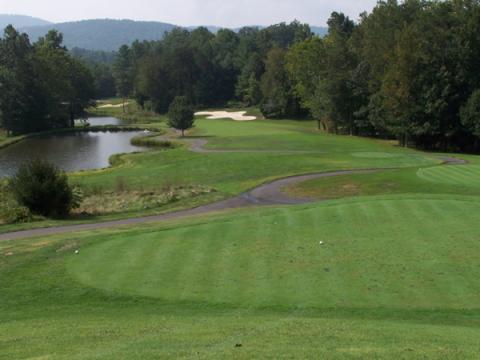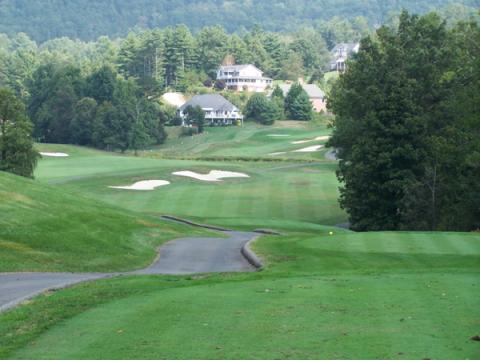Note to readers: Just a few more days of articles about Scotland, I promise (I need to amortize the exorbitant cost of the trip). Then we will return to discussions of golf real estate and related issues.
The Peat Inn is in the middle of nowhere, a good 25 minutes from St. Andrews. From any direction, the narrow roads to get there twist and turn and fall and rise past cow and sheep farms. At every bend you slow down lest the guy coming toward you from around the curve ahead fails to do the same.
After such a grip-the-wheel drive, the Peat Inn's antique and handsome façade was a welcome sight, and the maitre d's warm and friendly greeting made me forget
Peat Inn was named Best Rural Restaurant in Scotland.
the stress of the driving experience. But it takes more than friendly greetings to be voted the Best Rural Restaurant in Scotland, an honor bestowed on the
Peat Inn and its chef Geoffrey Smeddle last year. As it turns out, from that first welcome to the final equally hearty farewell, the Peat Inn shows why such lofty awards are within both its reach and grasp.
Maybe in recognition of what an effort it takes to get there, or more likely because it is the most expensive restaurant within a radius of hours, Peat Inn rushes nothing. You open the front door into a very pleasant lounge with a handful of tables and corner banquettes. Here you are invited to sit, order a drink and, only when you are fully settled in, to peruse the menu of the evening. The maitre d' is a pleasant chap who seems eager to answer any questions about the dishes of the night, and shows great patience when a nearby table of four wants every dish on the menu deconstructed.
We spare him a repeat performance since we have already heard it, and both of us order the special of the evening, the beef daube ($42), a hunk of meat marinated
The table of four wanted every dish deconstructed verbally.
for 24 hours and then slow cooked to a meltingly soft consistency. Before I can, my son Tim orders the terrific sounding langoustines and spiced pork belly, cauliflower panna cotta, peas and morel mushrooms ($20). We may never pass this way again, so I opt for another appetizer, the seared scallops, tomato confit and summer truffles ($12), and concoct plans to swipe a taste of Tim's starter.
After our drinks and the first "amuse bouches" of the evening, a small round of toast with a rich olive tapenade and an airy little parmesan puff, we are escorted into one of Peat Inn's three dining rooms. Our room, the farthest from the front door, looks out on the garden where the inn grows many of the herbs that embellish its dishes. Lovage, a member of the celery family, is one of them, and it is at the base of a foamy little soup our waiter presents us as the second amuse of the evening. It is shot through with a mild but distinctive plant flavor, a real palate cleanser. A crunchy fennel roll, one of four bread choices we are offered, complements the soup.
The appetizers arrive and they are stunners, if a bit dainty, not the relatively Bunyanesque portions we Americans are used to. Tim's plate is an exercise in
My son's appetizer was geometric, a rectangle of pork belly and perfect round of quivering panna cotta.
geometry, the pork belly a perfect rectangle of alternating layers of meat and fat laid astride a perfectly cooked crayfish. A round of quivering panna cotta, which I had only seen on dessert menus in its vanilla version, presents a subtle cauliflower flavor and refreshing cool taste that balances the gentle spice of the pork. My scallops are equally geometric, three medium-large pieces surrounding a little mound of confit that is pure essence of tomato. The accompanying "summer" truffles are pleasantly woodsy tasting mushrooms but certainly not the frightfully expensive ones that French pigs snuff out. The scallops are a tad overcooked but redolent of the sea nevertheless.
Oddly, we hit a bit of a snag with the entree. Obviously, the perfect square of beef, which is placed dead center on the plate, has been pampered by the slow-cooking method. It is properly soft but strangely lacking in either beef flavor or the flavor of whatever it marinated in for the advertised 24 hours. The red wine sauce helps only a little, but the little bits scattered about the plate -- oyster mushrooms, broad beans and radishes, all tasting as if they came from the garden out back -- are exquisite. Still, if I had a do over, I would have opted for the breast of duck with asparagus, potato gallette, young spinach and Calvados sauce ($38); or the roast rump of veal, saffron rice, peppers, fennel and oregano jus ($38).
I'm not a major dessert eater, but the listing for the hot peach soufflé with vanilla ice cream ($16) catches my eye, and I am willing to wait the 20 minutes the waiter warns me it will take. Tim, whose chocolate fetish comes from somewhere other than his father, goes for the dense and rich pavé of chocolate, chocolate brownie, raspberry mousse and raspberry sorbet ($16). When my soufflé is served, the waitress cuts a perfect crosshatch in the puffy crown and then slips a perfectly shaped dollop of ice cream, pointed at both ends, into the opening. I watch it slide in, the performance a nice opening act to the actual eating of the thing, which is light, airy, peachy keen and worth the wait. I don't bother Tim, who appears fairly hypnotized by his striking plate of reds and dark browns.
The Peat Inn's final gift to us is a small plate of six chocolates, three for each. Even in the better restaurants, these last little parting gifts seem almost reflexive, but at Peat Inn they are special. The log of crushed hazelnuts and chocolate is intense, rising beyond the familiar taste of a packaged Perugina. Mint from the garden was clearly used in the piece of mint chocolate, such was its intensity of flavor. But the most unusual piece was the jasmine tea chocolate, the tea equivalent of a cup of mocha coffee, something I had never tasted before but certainly look forward to again.
All the free stuff moderated just a little the sting of the prices at the Peat Inn. (A set menu of appetizer, salmon entrée, dessert or cheese and coffee and petits fours would have saved a few dollars, but we wanted free range of the menu for what may be my one and only trip to the area.) The inn is not for the faint of wallet, especially with the current exchange rates. When all was said and done, our meal cost $220. For perspective, it cost more than $600 for the two of us to play the Old Course at St. Andrews a few days earlier.
That was worth it too.
The Peat Inn, Cupar, Fife, Scotland. Tel: (01334) 840-206. Web: http://www.thepeatinn.co.uk/index.htm. Starters: $16 to $28. Entrees: $32 to $42. Dessert: $16 to $18. Set menu of the day: $64. Tasting menu: $96; $170 with selection of wines. 17.5% Value Added Tax included (thankfully).

























